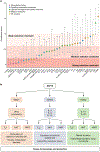A multilayered immune system through the lens of unconventional T cells
- PMID: 34290426
- PMCID: PMC8514118
- DOI: 10.1038/s41586-021-03578-0
A multilayered immune system through the lens of unconventional T cells
Abstract
The unconventional T cell compartment encompasses a variety of cell subsets that straddle the line between innate and adaptive immunity, often reside at mucosal surfaces and can recognize a wide range of non-polymorphic ligands. Recent advances have highlighted the role of unconventional T cells in tissue homeostasis and disease. In this Review, we recast unconventional T cell subsets according to the class of ligand that they recognize; their expression of semi-invariant or diverse T cell receptors; the structural features that underlie ligand recognition; their acquisition of effector functions in the thymus or periphery; and their distinct functional properties. Unconventional T cells follow specific selection rules and are poised to recognize self or evolutionarily conserved microbial antigens. We discuss these features from an evolutionary perspective to provide insights into the development and function of unconventional T cells. Finally, we elaborate on the functional redundancy of unconventional T cells and their relationship to subsets of innate and adaptive lymphoid cells, and propose that the unconventional T cell compartment has a critical role in our survival by expanding and complementing the role of the conventional T cell compartment in protective immunity, tissue healing and barrier function.
© 2021. The Author(s), under exclusive licence to Springer Nature Limited.
Conflict of interest statement
Figures




References
-
- Godfrey DI, MacDonald HR, Kronenberg M, Smyth MJ & Van Kaer L NKT cells: what’s in a name? Nat. Rev. Immunol 4, 231–237 (2004). - PubMed
-
- Lu L, Werneck MBF & Cantor H The immunoregulatory effects of Qa-1. Immunol. Rev 212, 51–59 (2006). - PubMed
-
- Colmone A & Wang C-R H2-M3-restricted T cell response to infection. Microbes Infect 8, 2277–2283 (2006). - PubMed
-
- Bendelac A, Savage PB & Teyton L The biology of NKT cells. Annu. Rev. Immunol 25, 297–336 (2007). - PubMed
-
- Cohen NR, Garg S & Brenner MB Antigen presentation by CD1 lipids, T cells, and NKT cells in microbial immunity. Adv. Immunol 102, 1–94 (2009). - PubMed
Publication types
MeSH terms
Substances
Grants and funding
LinkOut - more resources
Full Text Sources

